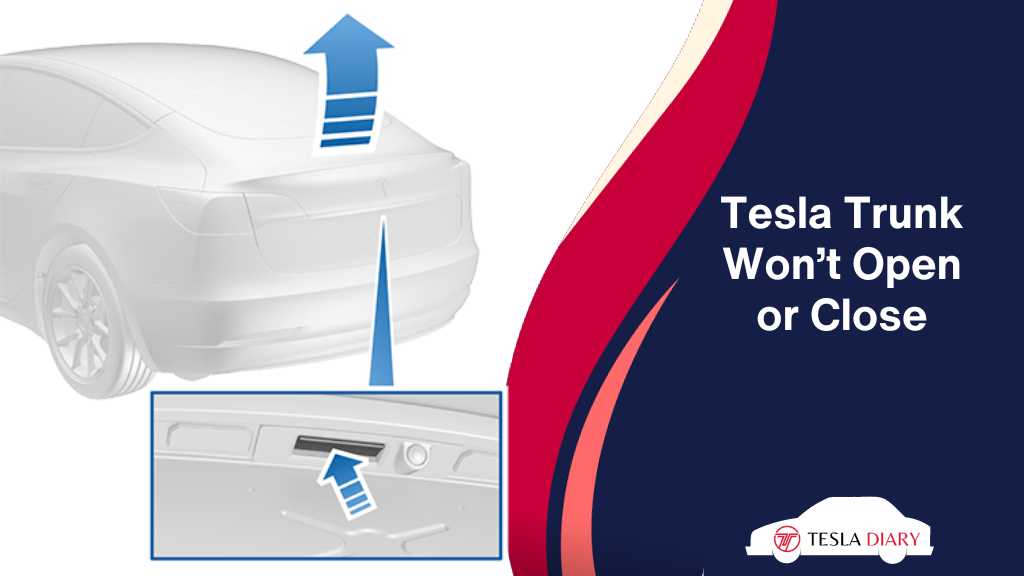Like any vehicle, Tesla can experience occasional issues. One common problem that Tesla owners may encounter is a rear trunk that won’t open or close as expected.
This can be frustrating, especially if you need access to your trunk for storage or retrieval of items.
In this article, we will explore some common reasons why a Tesla rear trunk may not open or close properly and provide solutions to help you resolve the issue.

Common Causes of Tesla Rear Trunk Issues
Tesla trunk can malfunction due to battery issues, software bugs, physical obstruction, trunk latch going bad, and Key fob or mobile app connectivity problems. You can solve the trunk not opening or closing issue by finding out the root of the problem and applying the fix provided in the article below.
Here are the solutions to your trunk not opening or closing issue-
1. Battery or Power Issues
One of the primary reasons your Tesla rear trunk may not open or close is related to the vehicle’s power supply.
If the 12-volt battery is weak or dead, it can lead to various electrical malfunctions, including problems with the trunk operation.
Additionally, issues with the main battery pack or a failure in the power distribution system can also impact trunk functionality.
Solution:
To address battery or power issues, ensure that your 12-volt battery is in good condition and charged. If the 12-volt battery is the culprit, you will see a low voltage battery warning on your center touchscreen.
If that’s not the cause, move to the next step.
2. Software Glitches
Tesla vehicles receive regular over-the-air software updates, which can sometimes introduce bugs or glitches that affect various vehicle functions, including trunk operation.
You know the issue is with the software if the problem started after a firmware update.
Solution:
In some cases, a simple software reset or a full vehicle restart can resolve software-related trunk issues.
To perform a soft reset,
- Park your car.
- Press the brake pedal and release.
- Press and hold both the scroll wheels on the steering wheel for about 10 seconds.
- Release the buttons when the touchscreen goes black and the Tesla “T” logo reappears.
If the issue persists, contact Tesla support for guidance on potential software fixes. They can resolve any software issue without you noticing anything over the air. Pretty cool, hah?
3. Physical Obstructions
Sometimes, physical objects or obstructions in the trunk area can prevent it from opening or closing properly.
This can include luggage, cargo, or even loose items that have shifted within the trunk.
Solution:
Inspect the trunk area for any visible obstructions. Remove any items that may be blocking the trunk’s path, and try operating it again.
Ensure that the trunk lid closes securely without any obstructions in its path.
4. Trunk Latch or Strut Problems
The trunk latch or struts that assist in opening and closing the trunk can wear out or become damaged over time.
If they malfunction, they can prevent the trunk from operating correctly.
Solution:
If you suspect an issue with the trunk latch or struts, it’s best to consult a Tesla service technician. They can diagnose the problem and replace any faulty components as needed.
It is not recommended to attempt any hardware fix in Tesla unless you have enough experience in doing so.
5. Key Fob or Mobile App Connectivity
Sometimes, connectivity issues between your Tesla’s key fob or mobile app and the vehicle can lead to trunk problems.
If your key fob battery is low or if there’s a temporary issue with the mobile app, it may not communicate properly with the car.
Solution:
Ensure that your key fob is functioning correctly and its battery has sufficient charge, and try using the mobile app to control the trunk.
If the issue persists, try restarting your mobile device or contacting Tesla support for assistance.
Conclusion
A Tesla rear trunk that won’t open or close can be a frustrating experience, but many of these issues can be resolved with some basic troubleshooting.
By checking for common causes like battery issues, software glitches, physical obstructions, or problems with the trunk latch and struts, you can often identify and fix the problem yourself.
If you’re unable to resolve the issue, don’t hesitate to reach out to Tesla’s customer support or visit a Tesla service center for professional assistance.
With the right approach, you can get your Tesla’s trunk back in proper working order and continue enjoying the benefits of your electric vehicle.

